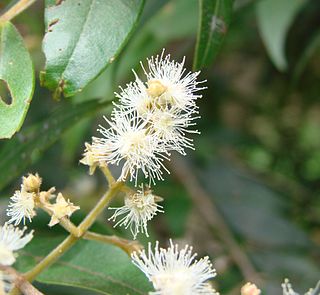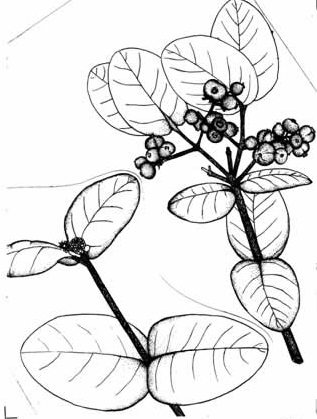
Myrtaceae, the myrtle family, is a family of dicotyledonous plants placed within the order Myrtales. Myrtle, pōhutukawa, bay rum tree, clove, guava, acca (feijoa), allspice, and eucalyptus are some notable members of this group. All species are woody, contain essential oils, and have flower parts in multiples of four or five. The leaves are evergreen, alternate to mostly opposite, simple, and usually entire. The flowers have a base number of five petals, though in several genera, the petals are minute or absent. The stamens are usually very conspicuous, brightly coloured, and numerous.

Ugni is a genus of plants in the myrtle family Myrtaceae, described as a genus in 1848. It is native to western Latin America from the Valdivian temperate rain forests of southern Chile and adjacent regions of southern Argentina, north to southern Mexico.

The Serra do Mar coastal forests is an ecoregion of the tropical moist forests biome. It is part of the Atlantic Forest of eastern South America. This ecoregion has an outstanding biodiversity consisting of flora, mammals, birds, and herpetofauna.

Myrcia is a genus of plants in the family Myrtaceae, containing about 765 species as of 2022. They are distributed in Central and South America, Mexico, and the Caribbean, with centers of diversity in the Brazilian Cerrado and Atlantic Forests ecoregions. Myrcia was first described as a genus in 1827.

Myrcia sintenisiana is a species of flowering plant in the family Myrtaceae. It is endemic to Puerto Rico, where it is limited to the Luquillo Mountains. It occurs in El Yunque National Forest in dwarf forest habitat on wet mountain ridges. Its common name is beruquillo.

Nepenthes micramphora is a tropical pitcher plant known only from Mount Hamiguitan on the island of Mindanao in the Philippines. It is a highland plant growing at elevations of 1100–1635 m.
Balanophora coralliformis, sometimes known as coral plant, is a flowering plant in the family Balanophoraceae and is known only from Mount Mingan on the island of Luzon in the Philippines. Like others in its genus, it is an obligate parasite growing on the roots of rainforest trees, but differs in that its tuber appears above ground and has an elongated, repeatedly branched, coral-like structure. It was first described in 2014 and is known from fewer than 50 plants, but has not as yet been declared endangered.

Myrcia guianensis (pedra-ume-caá) is a species of plant in the genus Myrcia of the family Myrtaceae native to South America.

Myrciaria glazioviana, the cabeluda, or yellow jaboticaba, is a species of plant in the family Myrtaceae.
Myrcia crassa is a species of plant in the family Myrtaceae. It is endemic to the municipality of Santa Teresa, Espírito Santo, Brazil, where its habitat is fragmented and declining due to deforestation. The tree was first described in 2010 and grows to between 1.5 and 18 metres tall.
Plinia rivularis, commonly known as yva poroity, jaboticabarana, jabúriti, guapuriti, cambucá peixoto, jabuticaba de cacho, or piuna is a species of plant in the family Myrtaceae.
Eugenia subterminalis, commonly known as cambuí pitanga, cereja do mato verdadeira, pitanga lisa de sombra, pitanga preta, and cambuízão vermelho do rio Paranapanema, is a species of plant in the family Myrtaceae. It is endemic to araucária forest in Bolivia, northern Brazil, Colombia, Ecuador, and Peru. The plant is a semi-deciduous shrub that grows to between 2 and 4 metres tall, and produces egg shaped fruit between 15 and 25mm tall, and 18 to 20mm wide.
Myrciaria cambuca, named after its common name cambucá, is a species of plant in the family Myrtaceae. First described in 2019, it is a small shrub with reddish fruit, and was previously misidentified as Myrciaria ferruginea.
Myrciaria una is a species of plant in the family Myrtaceae. First described in 2019, it is a tree or treelet with blackish fruit, and was previously misidentified as Myrciaria ferruginea.

Syzygium claviflorum is a tree in the Myrtaceae family. It is native to the north of the Australian continent and in tropical and subtropical Asia. It is used for timber, as fuel, as human and cattle food, and for dye. Stunted specimens can be found on the top of the plateau of Bokor National Park, Cambodia.
Myrcia ascendens is a species of plant in the family Myrtaceae, endemic to Bahia in north-east Brazil, and first described in 2015.
Myrcia attenuata is a species of plant in the family Myrtaceae, endemic to French Guiana, and first described in 2015.
Myrcia costeira is a species of plant in the family Myrtaceae, endemic to the south and south-east of Brazil, and first described in 2015.
Myrcia rupestris is a species of plant in the family Myrtaceae, endemic to south-east Brazil, and first described in 2015.
Metrosideros tabwemasanaensis is species of plant in the family Myrtaceae. It is a tree endemic to Mount Tabwemasana on the island of Espiritu Santo in Vanuatu.








